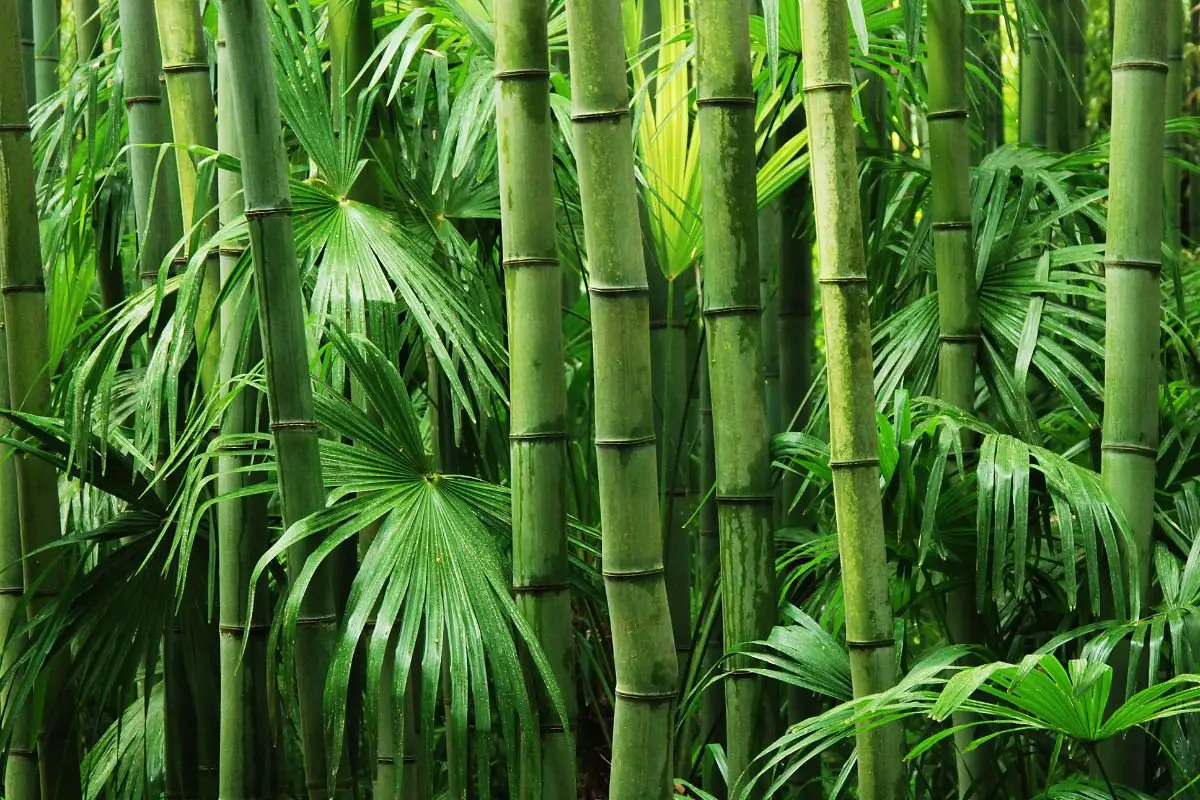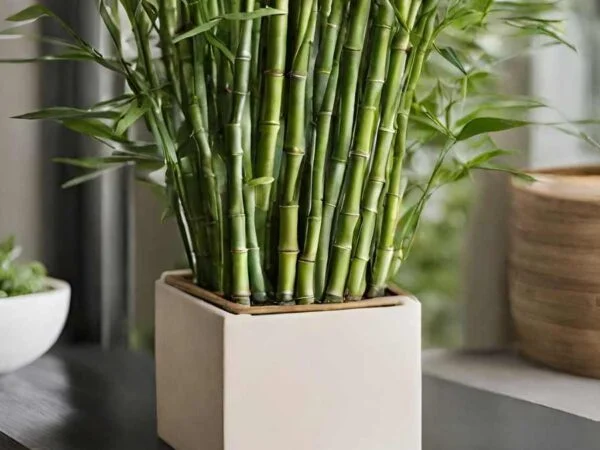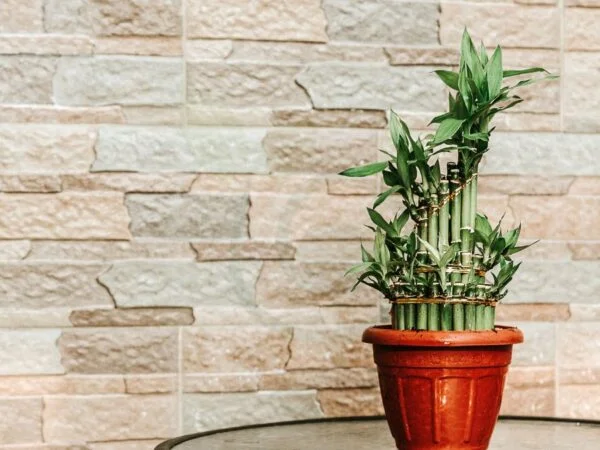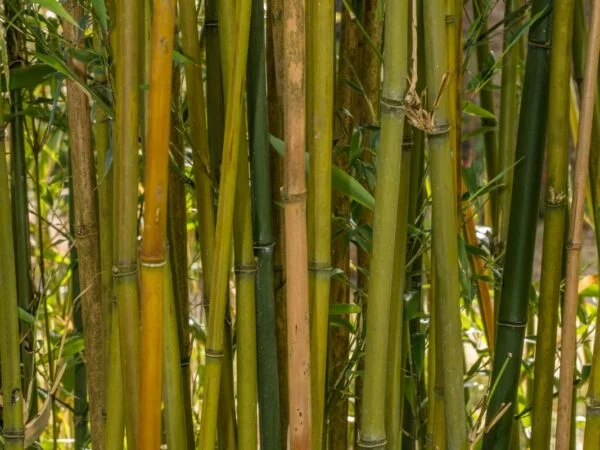
Have you ever wondered what a bamboo plant looks like? The appearance of bamboos with narrow leaves is distinct and recognizable, making it a unique addition to any garden or indoor space. With its tall, slender stalks and lush green leaves, the bamboo plant exudes a sense of tranquility and elegance. Its graceful form and vibrant foliage can instantly elevate the aesthetic appeal of any environment.
Curious to learn more about the fascinating characteristics of bamboo plants? Stay tuned as we delve deeper into the visual features, growth patterns, and bamboo roots of these versatile botanical wonders. Discover how to identify different species and cultivate your own stunning bamboo oasis.
Key Takeaways
- Identify Bamboo Species: Learn to distinguish different bamboo species, plant, based on unique characteristics like size, leaf shape, and growth habits.
- Care for Bamboo: Ensure the health of your bamboo plants by providing adequate water, sunlight, and soil conditions as per their specific requirements.
- Propagate Bamboo: Explore methods such as division, rhizome cuttings, or planting seeds to propagate bamboo and expand your collection.
- Choose the Right Bamboo: Select bamboos that suit your climate, space constraints, and aesthetic preferences for a successful and visually appealing garden.
- Explore Indoor Bamboo Options: Discover suitable bamboo species for indoor cultivation to bring a touch of greenery and tranquility to your living spaces.
- Accelerate Bamboo Growth: Implement strategies like proper fertilization, regular pruning, and optimal environmental conditions to encourage faster growth and lush foliage in bamboos.
Bamboo Basics

What is Bamboo
Bamboo, a type of grass plant, features tall stalks known as culms. It is categorized into clumping bamboos and running bamboos, famous for its rapid growth and versatility.
Unique Features
Bamboo possesses distinctive rhizomes that dictate its growth direction. Various bamboo types, a plant, offer unique characteristics suitable for different applications. Its strength and flexibility make it a popular choice in construction.
Growth Patterns
Clumping bamboo develops in a circular manner near the original plant, while running bamboo spreads rapidly through its rhizomes. Understanding these growth patterns aids in selecting the most appropriate bamboo species for specific requirements.
Uses of Bamboo
Construction Material
- Giant timber bamboo species are favored in construction due to their height and durability.
- Bamboo culms find applications in constructing buildings, furniture, and scaffolding.
- The eco-friendly nature and durability of bamboo, a plant, make it an environmentally sustainable construction material.
Garden Aesthetics
- Tall varieties of bamboos are perfect for creating privacy screens and sound barriers in gardens.
- Dwarf types can serve as ground cover and help control erosion.
- Bamboo enhances garden landscapes with elegance and tranquility.
Culinary Uses
- Bamboo shoots are widely used in Asian cuisine for their crunchy texture and subtle taste.
- These shoots can be incorporated into stir-fries, soups, salads, offering versatility in cooking.
Identifying Bamboo Species
Black Bamboo
Black bamboo stands out with its dark culms, providing a visually striking appearance in gardens. This variety creates a dramatic contrast in landscaping designs, making it highly desirable for ornamental purposes.
- The ornamental value of black bamboo is widely recognized.
- Its dark culms offer a unique aesthetic appeal to outdoor spaces.
Growth Habits
Bamboo, especially running species, displays vigorous growth habits that require careful management. Understanding these growth patterns is crucial for effectively controlling and containing the spread of bamboo within a specific area.
- Managing bamboo's growth involves pruning and regular maintenance.
- Proper care techniques are essential to prevent bamboo from becoming invasive.
Visual Characteristics
Various bamboo species showcase an array of colors, including yellow, red, and black, enhancing the visual diversity in landscapes. The distinct hues contribute to the overall aesthetic value of outdoor settings.
- The visual allure of bamboo adds charm and elegance to gardens.
- Each species possesses unique visual traits that make them stand out.
Bamboo Growth Cycle
New Shoots Emergence
Bamboo produces new shoots during the growing season, indicating its vitality and growth potential. Monitoring this emergence is crucial for assessing the plant's health.
The emergence of new shoots in bamboo signifies a fresh beginning and the plant's readiness to thrive. By observing this process, gardeners can gauge the overall well-being of their bamboo plants.
Development Process
Bamboo goes through a growth process, starting from tender shoots to developing into mature culms. Understanding this development journey is essential for proper care and maintenance.
The growth stages of bamboo, from shoots to culms, require specific attention and nurturing to ensure healthy development. Proper care practices contribute significantly to the plant's overall growth and vitality.
Colony Expansion
Certain types of bamboo, such as running species, exhibit a tendency to expand rapidly, potentially invading other areas of the garden. To manage this expansion, containment measures are necessary.
Managing the colony expansion of running bamboo involves strategic planning and implementation of containment strategies. By controlling its spread, gardeners can maintain a well-organized and aesthetically pleasing garden space.
Caring for Bamboo
Optimal Soil Conditions
Bamboo thrives in well-draining, fertile soil, which is crucial for its growth and development. Maintaining optimal soil conditions is key to ensuring that your bamboo plants remain healthy and vibrant. Soil pH levels are particularly important when it comes to cultivating bamboo successfully.
Sunlight Requirements
Bamboo requires adequate sunlight to carry out photosynthesis effectively and support its growth. By understanding the sunlight requirements of bamboo, you can strategically place your plants in areas where they receive the right amount of sunlight. Providing the appropriate sunlight exposure is essential for promoting lush and vigorous bamboo growth.
Fertilizing Guide
Regular fertilization during the growing season is highly beneficial for bamboo plants as it nourishes them and supports their overall health. Choosing the suitable fertilizer type and applying it correctly are critical steps in ensuring that your bamboo thrives. Proper fertilization not only encourages strong culm (stem) development but also contributes to dense foliage, enhancing the beauty of your bamboo garden.
Propagating Bamboo
Effective Techniques
Pruning bamboo plants correctly is crucial for maintaining their shape and structure. By trimming the excess growth, you promote healthier and more aesthetically pleasing bamboo. Regular maintenance practices, such as watering and fertilizing, are essential for the optimal growth and overall health of bamboo plants. These practices ensure that the bamboo receives the necessary nutrients to thrive.
Implementing effective techniques not only promotes healthy growth but also enhances the appearance of bamboo plants. Proper care results in vibrant green foliage and sturdy culms, adding to the beauty of your garden or landscape. By following best practices in planting and nurturing bamboo, you can create a visually appealing and sustainable environment.
Managing Invasive Growth
Certain species of bamboo, like running bamboo, have invasive tendencies if left unchecked. To prevent rampant spread, it is essential to implement containment measures. This includes using barriers or root pruning to control the growth of invasive bamboo species effectively. Regular monitoring of your bamboo plants is crucial to detect any signs of invasive behavior early on.
Controlling invasive bamboo growth requires consistent maintenance efforts. By regularly inspecting your plants for signs of overgrowth or spreading, you can take timely action to contain them. Implementing proactive measures ensures that your bamboo remains well-contained within desired boundaries, preventing it from encroaching on other areas of your garden or property.
Choosing the Right Bamboo
Indoor vs Outdoor
Bamboo thrives in both indoor and outdoor settings, depending on the specific species. The key lies in understanding the distinct care requirements for each environment to ensure optimal growth. Creating a suitable habitat is crucial for the successful cultivation of bamboo plants.
- Pros:
- Versatility in growing locations
- Adaptable to different environments
- Cons:
- Requires regular monitoring and maintenance
- Susceptible to pests and diseases if not cared for properly
Distinguishing between invasive and non-invasive bamboo types is vital when selecting the right variety for your garden. Non-invasive species are often preferred due to their controlled growth patterns, making them ideal for landscaping purposes. By opting for non-invasive bamboos, you contribute to preserving the ecosystem's balance.
Invasive vs Non-invasive
Understanding the distinction between invasive and non-invasive bamboo species is crucial for gardeners. Invasive bamboos have aggressive spreading tendencies that can disrupt local flora and fauna. On the other hand, non-invasive varieties offer beauty without compromising environmental integrity.
- Invasive Bamboo:
- Rapid spread can overtake native plants
- Difficult to contain once established
- Non-Invasive Bamboo:
- Controlled growth suitable for gardens
- Minimal impact on surrounding vegetation
When choosing bamboo plants, consider factors like growth habits, climate suitability, and intended use. Opting for non-invasive varieties not only enhances your garden's aesthetics but also contributes to maintaining a healthy ecosystem.
Lucky Bamboo Insights
Not True Bamboo
Lucky bamboo, part of the Dracaena genus, resembles bamboo but is botanically different. Understanding this difference is crucial for proper care. Popular for symbolism and ease of maintenance.
Care Tips
Proper care for lucky bamboo involves regular watering and ensuring good drainage. Healthy growth requires adequate sunlight and nutrient provision. Specific care guidelines are vital.
Indoor Bamboo Options
Low Light Varieties
e bamboo species thrive in low light conditions, making them perfect for indoor settings with limited sunlight. Understanding the light requirements of these varieties is crucial for their well-being.
Choosing low light bamboo ensures they can adapt and flourish even in environments where natural light is scarce. This adaptability makes them a popular choice for indoor decoration.
Indoor Care Tips
Indoor bamboo plants require sufficient humidity levels to thrive and grow optimally. Proper ventilation and air circulation play a vital role in maintaining the health of indoor bamboo.
Regularly dusting the leaves helps prevent dust build-up, ensuring the plant can photosynthesize efficiently. Monitoring for pests like spider mites or aphids is essential to catch any issues early on.
Accelerating Growth
Timing New Shoots
Timing the emergence of new shoots helps in tracking bamboo growth cycles. Monitoring new shoot development aids in assessing bamboo plant health. Understanding the timing of new shoots guides in proper care and maintenance.
Enhancing Growth Rate
Providing adequate water and nutrients enhances the growth rate of bamboo. Implementing proper pruning and maintenance practices promotes vigorous growth. Enhancing the growth rate results in lush foliage and robust culms.
Summary
You've learned all about bamboo, from identifying different species to caring for them and even accelerating their growth. By understanding the basics and nuances of bamboo plants, you're now equipped to choose the right one for your space and ensure its proper care. Remember to select indoor bamboo varieties wisely and propagate them correctly to enjoy the benefits they bring to your surroundings.
Now it's time to put your newfound knowledge into action. Choose the perfect bamboo plant for your home, follow the care tips diligently, and watch it thrive. Share your success with others and spread the joy of cultivating these beautiful and beneficial plants in your living spaces. Happy planting!
Frequently Asked Questions
What are the basic characteristics of bamboo plants?
Bamboo plants are tall, woody grasses with slender stems called culms. They typically have long, narrow leaves that grow in clusters along the culms. The appearance can vary depending on the species, but most bamboo plants have a distinctive jointed structure.
How can I identify different species of bamboo?
Identifying bamboo species involves looking at key features such as leaf shape, size, and color, culm diameter, and overall height. Examining the growth habit (clumping or running) and habitat preferences can help distinguish between various types of bamboo.
What is the growth cycle of bamboo plants?
Bamboo follows a unique growth cycle where new shoots emerge from the ground each year during the growing season. These shoots grow rapidly into mature culms within a few months. After reaching maturity, bamboos focus on expanding their root system before producing new shoots in subsequent years.
How do I care for my bamboo plant to ensure healthy growth?
To care for bamboo plants effectively, provide well-draining soil, adequate water, and regular fertilization during the growing season. Control invasive tendencies by planting clumping varieties or using barriers for running types. Regularly check for pests and diseases while ensuring proper sunlight exposure.
What are some methods for propagating bamboo?
Bamboo propagation methods include division (splitting rhizomes), culm cuttings (using sections of mature culms), and layering (encouraging roots on a branch still attached to the parent plant). Each method has its own requirements and success rates, so choose one that suits your specific situation and goals.
Image Source: Paid image from CANVA





